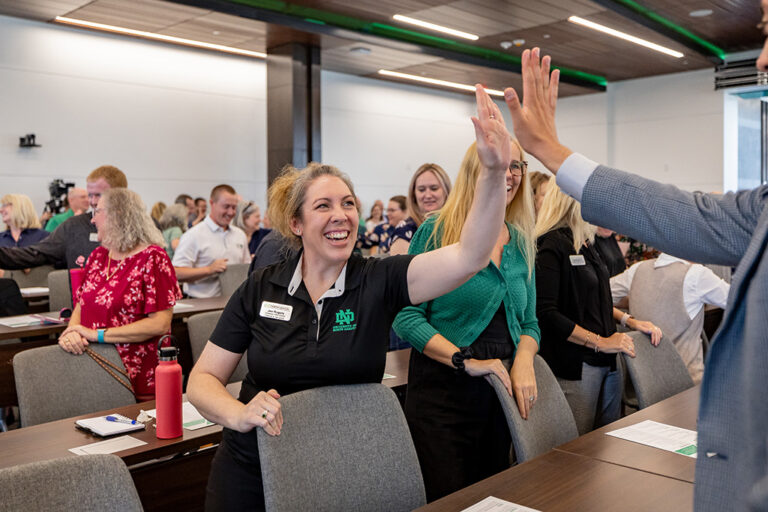Bringing it all back home
UND’s first MD graduate Dr. Robert Arusell on medical education, oncology, and establishing an annuity to support the UND School of Medicine & Health Sciences
“Well, I was the first graduate simply due to my last name,” laughed Dr. Robert Arusell, the inaugural graduate (MD ’76) of the UND School of Medicine & Health Sciences (SMHS) four-year MD program. (Prior to 1976, UND granted a two-year BS Med degree.) “There is a videotape of me walking across the stage in a leisure suit I’d bought for the occasion.”
Reflecting upon both his medical education and more than 33 years as a Fargo-based radiation oncologist, Arusell smiled at how much has changed since the 1970s.
“When I started, you had to do a lot memorizing and computing in your head – we even used a slide rule,” the physician recalled of his radiation oncology residency at Mayo Clinic in Rochester, Minn., which he completed around the same time his spouse, Velva, N.D., native Janelle Sanda (MD ’81), was completing an internal medicine residency in Iowa. “The use of computers has been huge in radiation oncology. It paved the way for imaging with CT scanners and MRI machines to better pinpoint cancers. During my residency, a dose calculation for a radiation implant could take an hour – now it takes less than a minute.”
Indeed, beyond medical technology and fashion—no more leisure suits—the cost of medical education, for both students and institutions, has changed as well.
“Back in the seventies our tuition was only $1200 a year,” continued the Steele, N.D., native Arusell, noting how in-state tuition is now $36,000 annually for SMHS medical students (which is still well below average for U.S. medical schools). “This was a great opportunity to receive an affordable, quality education and stay in-state.”
The cost of education notwithstanding, Arusell mused on how medical training itself has evolved.
“Students do small-group sessions with active learning now, rather than the traditional lecture-only model,” he said. “My wife and I had to memorize drugs and doses, and we carried a Washington Manual in our white coats and copied pertinent journal articles to store in files. Now students can readily access this information online.”
In an effort to help give back to both students and the School that gave them their careers, then, in 2008 Drs. Arusell and Sanda established an endowed professorship with the SMHS.
They did so in an effort to further contribute to the teaching of medical students. After all, both physicians served as clinical associate professors for the SMHS, teaching residents and medical students on clinical rotations in Fargo.
And today, the couple’s endowment will have an additional source of funding through a unique gifting strategy: a portion of Arusell’s individual retirement account (IRA).
In 2022, the U.S. Congress passed the Secure Act 2.0, which allows an individual to use their IRA to fund, once in their lifetime, a charitable gift annuity (CGA) up to $53,000 via a Qualified Charitable Distribution (QCD). A CGA is a gift instrument where a donor makes a gift to the UND Alumni Association & Foundation (AAF), for example, and the AAF provides the donor with annual income.
Consider a retired physician, age 73, who wants to support the UND SMHS, but needs to take a Required Minimum Distribution (RMD) from her IRA. One option is to establish a $50,000 charitable gift annuity funded from the IRA, which would then satisfy the RMD at the same time as it benefits UND. The donor pays no income tax on the transfer and the gift will pay back 6.7% of the gift total annually, based on the donor’s age. This means that the donor will receive approximately $3,350 every year and can also designate any remaining balance to programs at the SMHS.
Once funded, CGAs provide fixed lifetime income for the donor and/or their spouse. Eligibility to take advantage of this gift strategy begins at age 70.5.
“When you reach your seventies, this annuity makes sense – it gives you a fixed income for the rest of your life,” Arusell said, noting that CGA rates are the highest they have been in 16 years. “The beauty of this is that it provides a tax savings and allows one the ability to do something beneficial for UND.”
It’s this sort of support for faculty and institutions that pays dividends of a different sort down the road for entire communities, noted the physician, referencing the state’s relatively new Hematology-Oncology Fellowship Program.
“Back in 1991, when we opened the Roger Maris Cancer Center, we were really one of the first places in the country to put medical oncology and radiation oncology right next to each other, with the lab, x-ray, pharmacy, and an infusion center right there in one building on one level,” Arusell said. “It was very patient-friendly. We had administrators and oncologists from all over the country coming to look at our center, even 12 years later. I feel good about that. We were able to do something that helped set a precedent for the future.”
Today, Arusell is hoping to set a different sort of precedent for UND alumni to follow, showing how other people “from all over the country” can support their alma mater in North Dakota in new ways.



